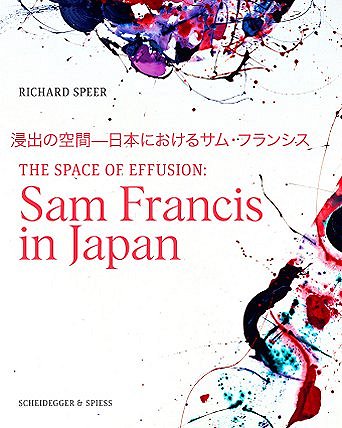

The Space of Effusion: Sam Francis in Japan
浸出の空間—日本におけるサム・フランシス


The Space of Effusion: Sam
Francis in Japan
浸出の空間—日本におけるサム・フランシス
by Richard Speer
リチャード・スピーア
著
edited
by Debra Burchett-Lere
デブラ・バーシェット・レア
編
from publisher
Scheidegger & Spiess, Zurich
in association with the
Sam Francis
Foundation
and
University of Chicago Press
"In many ways as monumental as the Abstract Expressionist artist’s work itself."
—Lauren W. Deutsch, The Kyoto Journal (Japan)
“A magnificent study, rich in discoveries and based on remarkable research...”
—LEXNEWS: Revue Culturelle (France)
"Stunningly
comprehensive... An exceptional, inspiring book."
—Moors
Magazine (The Netherlands)
“This
rich, subtle, and complex book... takes a deep dive
into the cultural and aesthetic reasons behind the Japanese embrace of Francis.”
—John Dorfman, Art & Antiques magazine (New York)
“Wonderful
and enlightening... this richly illustrated book is a must for all Sam
Francis fans...”
—Louise Gerber,
Cosmopolis: A Magazine on Current Affairs and Culture (Switzerland)
"Shows
convincingly how Japan inspired Francis's painting and how he, in turn,
influenced Japanese art...
a well-written, richly illustrated biography of work and person."
—Wolfgang Schwentker,
Fachbuchjournal (Germany)
a companion publication to the forthcoming exhibition
Sam Francis and Japan: Emptiness Overflowing
サム・フランシスと日本: 充満する虚空
Los Angeles County Museum of Art (LACMA)
Los Angeles, California, U.S.A.
April 9-July 16, 2023
co-curated by Hollis Goodall, Leslie Jones, and Richard Speer
in association with the
Sam Francis
Foundation
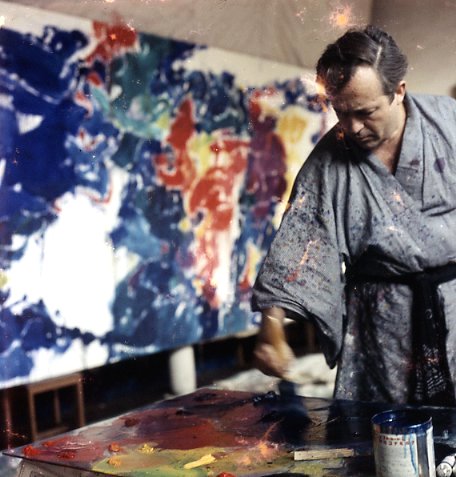
Sam Francis painting Tokyo
Mural for
Ikebana Sōgetsu in
Tokyo studio, 1957
Courtesy Sam Francis Foundation
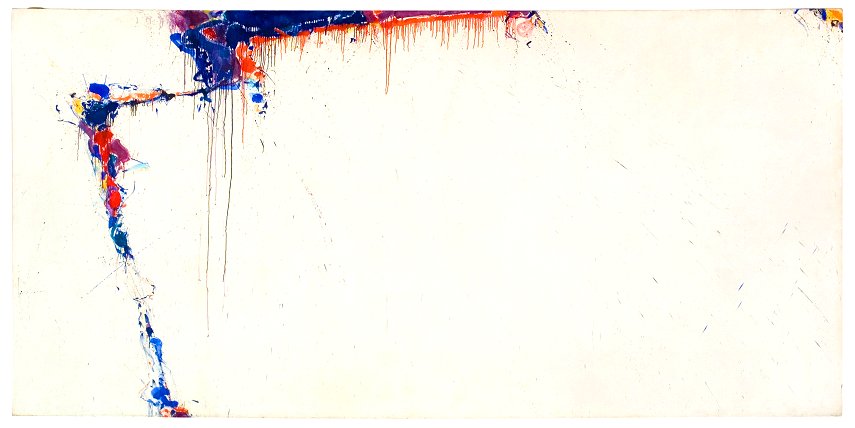
Japan Line (1957) by
Sam Francis
Courtesy Sam Francis Foundation
Press Release
"The white space in Sam Francis’s paintings struck Japanese viewers as a kind of reimagining of their own concept of ma (間), an intellectually nuanced and energetically charged interval between objects or ideas. In the meeting of Francis’s white and the Japanese ma, it was as if two souls were encountering one another across the East/West divide and exclaiming: “Yes, I recognize you! We share something important. Let us get to know one another.”
Art historian Richard Speer's new book, The Space of Effusion: Sam Francis in Japan, chronicles painter Francis's long and complex relationship with Japanese aesthetics, as well as his friendships and collaborations with Japanese artists, architects, poets, critics, composers, and filmmakers from the 1950s through the 1990s. One of the world's preeminent Abstract Expressionists, Francis (1923-1994) first traveled to Japan in 1957 and quickly became active in a circle of avant-garde artists and intellectuals that included architect Arata Isozaki; critic Yoshiaki Tōno; poets Shūzō Takiguchi, Makoto Ōoka, and Mamoru Yonekura; artist and flower master Sōfū Teshigahara; painters Toshimitsu Imai, Hisao Dōmoto, Hideo Kaido, Teruko Yokoi, and Takako Idemitsu; Japanese-American sculptor Isamu Noguchi; ceramicist Fujio Koyama; oil magnate and art collector Sazō Idemitsu; Gutai artists Jirō Yoshihara and Atsuko Tanaka; filmmakers Hiroshi Teshigahara and Mako Idemitsu; Korean-Japanese artist and Mono-ha theorist Lee Ufan; Mono-ha artists Kishio Suga and Jirō Takamatsu; writer Taeko Tomioka; gallerist/impresario Kusuo Shimizu; and composers Toshi Ichiyanagi, Tōru Takemitsu, and Teizō Matsumura.
Sam Francis and friends, Tokyo, c. 1965-66.
LTR: Shūzō Takiguchi, Takako Idemitsu, Yoshiaki Tōno, Sam Francis,
Hiroko Narasaki, Arata Isozaki, Mako Idemitsu, Hideo Kaido
It is widely known that Francis was influenced by Japanese art and philosophy, but less known that the painter significantly influenced many of his contemporaries in Japan, including key figures in the Gutai and Mono-ha movements. There was a feedback loop of mutual influence that spurred frequent collaborations, lifelong friendships, and shared creative growth. While many well-known American artists were broadly influenced by East Asian aesthetics—Mark Tobey, Robert Motherwell, Helen Frankenthaler, Franz Kline, David Smith, Morris Graves, and Richard Serra, to name only a few—Francis committed himself to Japan more comprehensively. He established studios and built a home there, where he lived and worked for extended periods; collaborated extensively with Japanese artists and writers; studied traditional pottery-making with Kanjiro Kawai, Rokubei Shimizu, and Fujio Koyama; married a Japanese painter (Teruko Yokoi), then, after their divorce, married a budding Japanese filmmaker (Mako Idemitsu), fathering children with both; integrated Japanese materials and techniques into his practice, including lithographs and etchings on fine Japanese papers; studied and spoke the language, if haltingly; and was instrumental in giving many of his Japanese colleagues their first exposure to the American and international art scenes. He did not just give “lip service” to Japan—he walked the walk. As Yoshiaki Tōno wrote, “his relation to Japan was deeper than that of any living Western artist at the time."
Through his original research inside and outside Japan, Richard Speer has uncovered the never-before-told story of one of the great intercultural dialogues of post-World War II art: a conversation between Eastern and Western sensibilities that prefigured our current era of instantaneous global communication and creative exchange. The Space of Effusion: Sam Francis in Japan is the first full-length monograph devoted to this important but sometimes overlooked period in 20th Century abstraction. It abounds with lavish color plates and never-before-published archival images, many of them sourced from the Sam Francis archives in the Getty Research Institute, Los Angeles. The book was edited by, and includes a foreword by, author/curator Debra Burchett-Lere, director and president of the Sam Francis Foundation and widely regarded as the world's foremost expert on Francis's life and work.
Sam Francis and Gutai artist Atsuko Tanaka in Francis's studio, Tokyo, ca. early 1960s
Courtesy Sam Francis Foundation
Misa Shin and Arata Isozaki, Karuizawa, Japan, 2017
Photograph by Richard Speer
The book's release coincides with the opening of Sam Francis and Japan: Emptiness Overflowing (October 4, 2020-January 24, 2021) at the Los Angeles County Museum of Art (LACMA). Speer co-curated this sprawling exhibition with Hollis Goodall (LACMA’s curator of Japanese art) and Leslie Jones (LACMA’s curator of prints and drawings), with curatorial assistance from Debra Burchett-Lere and the Sam Francis Foundation. It will pair Sam Francis masterpieces from LACMA-held and loaned collections with historical, modern, and contemporary Japanese screens, scrolls, etchings, drawings, paintings, and calligraphy from the mid-Edo Period to the late 20th Century. This is the first major museum survey devoted to Francis's ties to Japan. The pairing of works will demonstrate vividly the unlikely but unmistakable pictorial affinities between the art of ancient and modern Japan and the work of a towering figure among the second generation of Abstract Expressionists. The inexplicable melding of tension and serenity inherent in Japanese ma and Francis's negative space, is an unprecedented meeting of sensibilities across boundaries of time and culture.

(Left) Yanagi-bashi
or Willow Bridge over the Uji River (Anonymous), Ink and color on gold
paper/applied copper, ca. 1580-1600), LACMA
(Right) Spleen (Red), Sam Francis, Lithograph (1971) © Sam Francis
Foundation

Sam
Francis,
Untitled
Triptych,
1983. Acrylic on canvas, 243.84 x 852.17 cm (96" x 335").
Toyama Prefectural Museum of Art and Design, Toyama, Japan
Gift of The First Bank of Toyama Co., through Nantenshi Gallery, Tokyo (1989).
Photo by Brian Forrest, Santa Monica.
About the Author
Richard Speer is a critic, author, and curator based in Portland, Oregon, U.S.A. His books include Echoes Among the Tides (Centre Picasso, 2004), Matt Lamb: The Art of Success (John Wiley & Sons, 2005), Henry Hillman, Jr.: Illuminating the Fourth Dimension (Elizabeth Leach Gallery, 2008), Halley/Mendini (Mary Boone Gallery, 2013), Peter Halley: Boats Crosses Trees Figures—Gouaches 1977–78 (Karma, 2017), Eric Wert: Still Life (Pomegranate, 2018), George Dunbar (Callan Contemporary, 2018), and Journey to the Third Dimension: Tom Cramer Drawings and Paintings 1974–2019 (Jordan Schnitzer Museum of Art, 2019).
His reviews and essays have appeared in ARTnews, ArtPapers, Artpulse; Visual Art Source, Art, Ltd., Surface Design, The Los Angeles Times, The Chicago Tribune, The New York Post, Salon, Newsweek, and Opera News. An honors graduate in journalism and humanities of the Nicholson School of Communication (University of Central Florida, Orlando), he has won awards for his arts reporting from The Associated Press and The Society of Professional Journalists. As a curator he has organized exhibitions at institutions such as the Los Angeles County Museum of Art and the Jordan Schnitzer Museum of Art (University of Oregon) and has received curatorial grants from The Ford Family Foundation and the Sam Francis Foundation.
While researching Sam Francis in Japan he interviewed contemporaries, friends, and family members of Francis, among them Mako Idemitsu, Lee Ufan, Toshi Ichiyanagi, Kishio Suga, and Arata Isozaki, as well as curators, archivists, and scholars at Idemitsu Museum of Arts (Tokyo), Keio University of Arts (Tokyo), Ikebana Sōgetsu (Tokyo), Nichibunken/International Research Center for Japanese Studies (Kyoto), Toyama Prefectural Museum of Art and Design, and other institutions with ties to the painter.
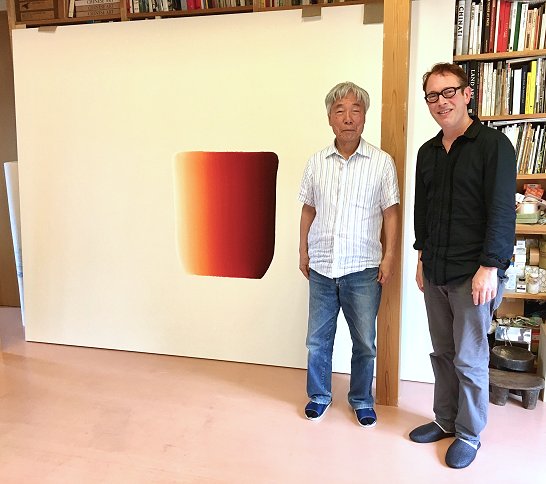
Lee Ufan and Richard Speer,
Kamakura, Japan, 2017
Photograph by Dorothy Goode
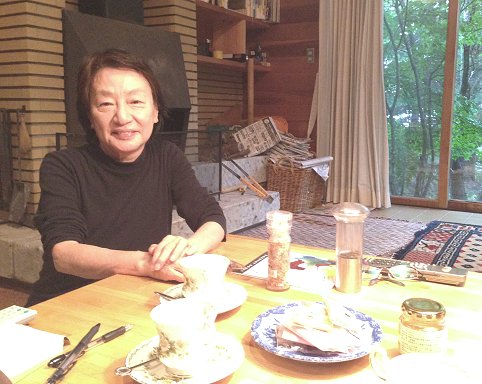
Mako Idemitsu, Karuizawa,
Japan, 2017
Photograph by Richard Speer

Toshi Ichiyanagi and Richard
Speer, Tokyo, Japan, 2017
Photograph by Dorothy Goode

(LTR): Aneta Zebala,
Debra Burchette-Lere, Kishio Suga, Richard Speer
Blum & Poe Gallery, Los Angeles, 2017
Photograph by Yusuke Nishimura